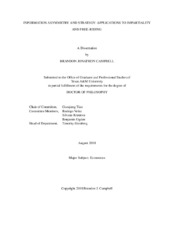| dc.contributor.advisor | Tian, Guoquiang | |
| dc.creator | Campbell, Brandon Jonathon | |
| dc.date.accessioned | 2019-01-17T23:13:35Z | |
| dc.date.available | 2019-01-17T23:13:35Z | |
| dc.date.created | 2018-08 | |
| dc.date.issued | 2018-07-31 | |
| dc.date.submitted | August 2018 | |
| dc.identifier.uri | https://hdl.handle.net/1969.1/173671 | |
| dc.description.abstract | This dissertation consists of three essays examining information asymmetry, in particular on
the topic of impartiality. The first two essays are in the form of the principle-agent model but
the third essay is a public goods game where the information asymmetry is among the agents
within the game.
The first essay is an implementation problem. In this juror problem, there is a true ranking
of contestants unknown to the designer but known to two biased jurors. The designer’s objective
is to discover the true ranking. This information is unverifiable and unknowable by any means
other than report from the two biased jurors. What the designer does know is the impartiality of
each juror’s preference. We find that to Nash implement the true ranking, the designer requires:
one, every pair of contestants is an impartial pair for some juror; two, the designer knows for
every contestant pair some juror for whom it is an impartial pair; three, impartial pairs are
distributed such that a construction of their lower contour sets overlap.
Instead of impartiality being a restriction on preferences as in the juror problem, we next
look at a literature survey of nomination rules with impartiality being a mechanism property. In
this literature survey, impartiality is a property of a nomination rule that does not allow an agent
to change his vote and lose his election. The literature survey establishes many impossibility
results but some viable nomination rules include a majority rule with default agent and partition
methods that culls an elect from partitioned (district) elections.
We finally consider a public-goods game where the charity is seeking to maximize total
donations. The information asymmetry is between two types of donors, informed and uninformed.
The informed donor is aware of the value of the common value public good while the
uninformed donor is not. The charity has the ability to choose the cost of donors becoming informed.
We find in this problem that the charity maximizes total expected donations by making
information costly such that the equilibrium is a mix of informed and uninformed donors. | en |
| dc.format.mimetype | application/pdf | |
| dc.language.iso | en | |
| dc.subject | Impartiality | en |
| dc.subject | Nash Implementation | en |
| dc.subject | Value of Information | en |
| dc.title | Information Asymmetry and Strategy: Applications to Impartiality and Free-Riding | en |
| dc.type | Thesis | en |
| thesis.degree.department | Economics | en |
| thesis.degree.discipline | Economics | en |
| thesis.degree.grantor | Texas A & M University | en |
| thesis.degree.name | Doctor of Philosophy | en |
| thesis.degree.level | Doctoral | en |
| dc.contributor.committeeMember | Velez, Rodrigo | |
| dc.contributor.committeeMember | Krasteva, Silvana | |
| dc.contributor.committeeMember | Ogden, Benjamin | |
| dc.type.material | text | en |
| dc.date.updated | 2019-01-17T23:13:36Z | |
| local.etdauthor.orcid | 0000-0003-1252-690X | |


